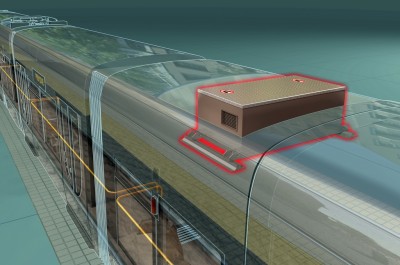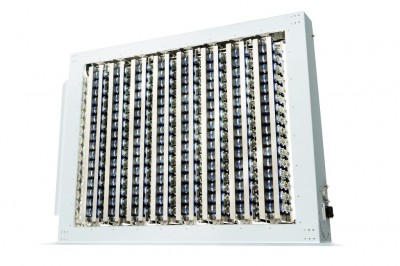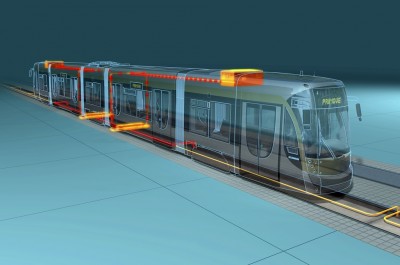 Trams all over the world could soon be operating without the eyesore of overhead cables according to Bombardier, the world’s leading supplier of trams. Primove, Bombardier’s new tram system, uses induction technology for the transfer of electric power. This contact-less technology is five to six percent more efficient than other technologies in current use, says Bombardier. Amsterdam council has already shown serious interest
Trams all over the world could soon be operating without the eyesore of overhead cables according to Bombardier, the world’s leading supplier of trams. Primove, Bombardier’s new tram system, uses induction technology for the transfer of electric power. This contact-less technology is five to six percent more efficient than other technologies in current use, says Bombardier. Amsterdam council has already shown serious interest
The First Prototype
Bombardier recently successfully presented its first prototype Primove tram in Bautzen, in the east of Germany. The induction technology powering the tram is similar to that used in electric tooth brushes and in induction cooking, although on a much larger scale.
The Primove system allows trams to operate in all environments without the use of overhead cables. This is particularly desirable in town centres and tourist areas.
Advantages for the Transportation Company
Advantages of the Primove system are:
- Easy installation
- No overhead cables
- Immunity to weather conditions – frozen cables, etc.
- Less wear due to contact-less energy transfer
- Smaller tram tunnels, because no overhead cabling is required
- Less maintenance
Operation
In Primove trams, the overhead cable is replaced by an underground cable between the rails. The principle of operation is similar to that of transformers, the primary circuit being in the ground and the secondary circuit built into the undercarriage of the tram. The electro-magnetic field between the primary and secondary circuit generates the electricity to drive the tram. Furthermore, the primary circuit is segmented, each segment being energised only when the tram is directly above. This ensures that the system is safe and that there is no danger to pedestrians.
Energy saving
The Primove tram is fitted with an integrated MITRAC energy saving system installed on its roof. This system consists of capacitors which store energy when the tram brakes and allows this energy to be used for acceleration. Tests conducted on a “light-rail” system in Mannheim since 2003 have shown that up to thirty percent less energy is required, greatly reducing costs and emission levels.

The Mitrac system on top of the tram
Initial purchase and installation costs of Primove, to replace existing trams, can be up to thirty percent more expensive than conventional alternatives. However according to Dr. Carsten Struve, director of Advanced Technology Development at Bombardier Transportation, the savings in energy and maintenance costs enable the investment to be recovered within six to ten years.
The Future
The first Primove trams are to be delivered in 2010. Induction systems for metro’s and trains are also on the drawing boards and should become available within five to ten years. Even safe and reliable induction systems for high speed trains are possible, says Dr. Carsten Struve. Bombardier also has plans for wireless trolley buses and possibly in the future an induction system for powering cars. Bombardier’s biggest competitors, Siemens, the manufacturer of the Amsterdam Combinotram, and the French Alsthom company also have induction systems in the planning.
Induction Powered Cars?
It sounds marvelous, an electric car that charges up its batteries while traveling, but what are the practical problems? With a tram, the power cable is positioned between the rails: but how could this be done on a public highway with many lanes? Placing a cable in the middle of each lane would be a huge installation undertaking, require an enormous amount of copper cable, and present considerable safety problems.

MITRAC Energy Storage System with Capacitors
A possible solution is to lay a cable alongside the highway which criss-crosses the highway every 500 metres or so. Vehicles passing over the cable would charge up a capacitor based storage unit capable of propelling the vehicle to the next cable, and charge up the vehicle’s batteries. The final part of a journey would be made on the batteries, thus cables need only be installed under main roads and highways. Such a system would minimize installation and safety problems and require far less copper cable. A payment system for the electricity would have to be agreed.
Any suggestions and comments about this solution are welcome.







19 replies on “Overhead Cable-Free Trams”
The PRIMOVE system is an interesting and thought provoking concept that could have ramifications way, way beyond its current envisioned implementation in light rail transport. For instance, electric buses could use such an energy source provided they can be driven in a reasonable straight line over the induction cable. There is one manufacturer that is interested in using the cable for both power extraction and as a guidance mechanism for rubber tired electric transit. And if buses work, why not extend the “consumers” to private electric vehicles. This has social implications. The authority installing the cable becomes a common service provider, selling electrical energy to individuals. There are many legal and liability issues that would confront a City administration on an electrical supplier in such a scheme.
The main problem with PRIMOVE at the moment is the tight-lipped response of Bombardier regarding installation difficulty and costs. I suspect they have a winner but have yet to determine how to market their new product beyond LRT.
.
see “Nissan induction powered cars.”
Nice…
Thanks, I always aprisiate a good read. Dont stop posting!…
http://www.bombardier.com/en/corporate/media-centre/press-releases/details?docID=0901260d80166b92
http://www.career.fu-berlin.de/career/out/CS_Praktikum_13679.pdf
Bombardier expects competition.
http://www.emc-mec.ca/ev2011ve/proceedings/EV2011VE27-T2s2-2_Ga%C3%ABtan%20Bilodeau.pdf
http://pubs.acs.org/doi/abs/10.1021/nl2018492
http://www.intelligentcitiesexpo.com/the-long-road-to-innovation-from-university-to-primovecity
http://www.newscientist.com/article/mg21228406.200-charge-your-electric-car-on-the-move.html
http://electronics.howstuffworks.com/everyday-tech/wireless-power2.htm
http://news.stanford.edu/news/2012/february/wireless-vehicle-charge-020112.html
http://www.g4v.eu/
http://www.vattenfall.com/en/pressreleasedetailhidden.htm?newsid=6F48045A7E8343AE8B211A9E429705CD
http://www.teslamotors.com/about/press/releases/tesla-motors-announces-further-commitments-netherlands
http://www.maxwell.com/products/ultracapacitors/docs/top_10_reasons_for_ultracaps.pdf
http://www.power-eetimes.com/en/understanding-wire-less-charging.html?cmp_id=71&news_id=222904584
http://www.maxwell.com/products/ultracapacitors/docs/maxwell_ultracapacitor_grid_storage_solutions.pdf
http://www.fisita2014.com/
Global approach to mobility.
http://ebook.digital2.org/i/inductive-charging-flanders-drive-book-w29280/
Rechargingsystems are usually developed for mobile phones etc.